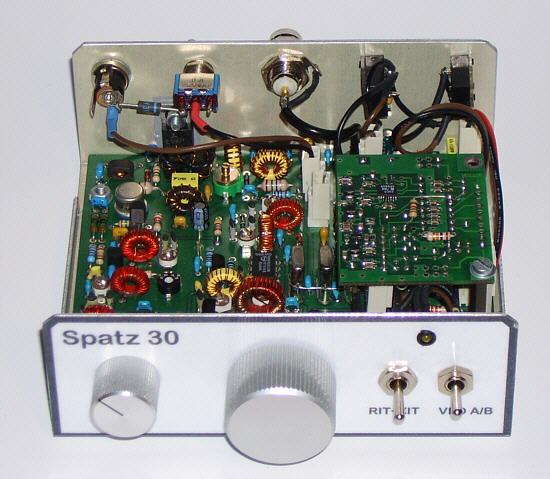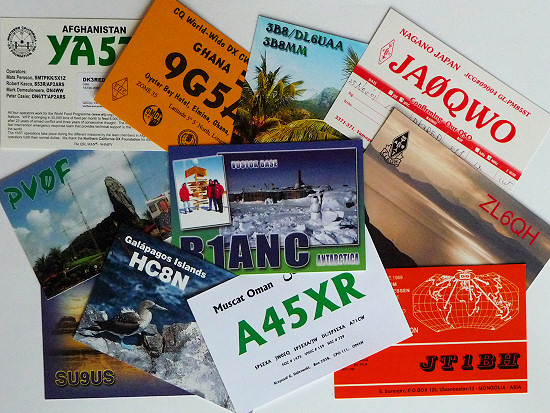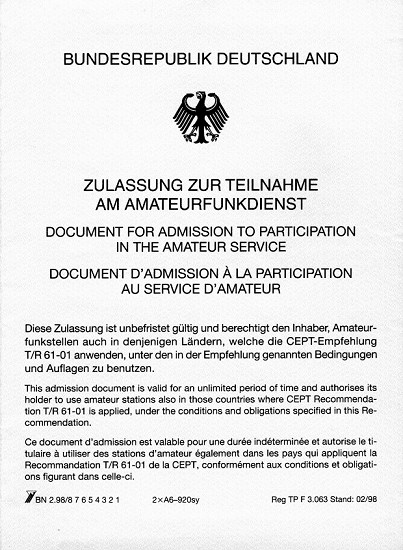Already at the end of the 19th and beginning 20th century James Maxwell, Heinrich Hertz, Édouard Branly, Alexander Popow and Guglielmo Marconi established the basis of radio engineering [1].
Without this people we could not use today for exeample no radios or televisions or mobile phones.
Beside the commercial users and the military also fast amateurs were interested in this area.
In the decades following some countries promoted the development of the amateur radio, other one faced it distrustfully.
But that changed meanwhile.
Amateur radio and radio amateurs 
Today amateur radio is in nearly all countries of the world established and in accordance with [2] "a radio service, which radio amateurs practice among each other, for experimental and technical-scientifically studies, for one's own education, for understanding among nations and for supporting of relief actions in emergencies and catastrophes."
A person, who practices this actions is named radio amateur.
A radio amateur in accordance with [3] is the "owner of an amateur radio licence oder a harmonized amateur radio certificate ... who engaging oneself with radio service out of personal interest and without commercial-economical interest."
Recapitulated amateur radio is consequently a technical hobby, whose fans (radio amateurs) devote oneself to wireless communication.
Spheres of action of amateur radio 
Amateur radio is a various operating field.
Many radio amateurs dedicate themselves to archive radio contacts, thus the talk with other radio amateurs world-wide.
Other radio amateurs are committed to build themselve in part or their entire radio communication system.
Some others understand amateur radio also as competition and participate in contests, radio direction findings and something like that.
It shouldn't be forgotten that radio amateurs also concerned with the development of software.
Usually there is however no radio amateur, who has only one motivation.
Everyone is concerned from more than one reason with the amateur radio.
Even if the amateur radio is only one hobby, it already smoothed the way to a new job for many technically interested people.
For a technical job or a practical training it can have an advantage, if one can refer to be radio amateur or be interested in it.
As a countermove many companies and institutions to support the training of radio amateurs.
But amateur radio is not only the leisure activities of some people.
Just in countries with large distances or only little developed infrastructure induce natural catastrophes again and again to the complete loss of normal communication.
Internet or telephone/mobile communications networks are then no longer usable.
Radio amateurs with their selfly-sufficient working radio stations represent then particularly often at the begin of the disaster the only chance of being able to set off emergency calls.
Amateur radio bands and amateur radio technique 
Radio amateurs can use these days 30 frequency ranges between 135.7 kHz and 250 GHz.
Thus offered the possibility of becoming active by the ranges of longwaves over the shortwaves until the far beyond ultra-short waves.
So also today's time each interested one can still participate in the development of the radio engineering and the study of the propagation conditions.
Beside direct radio contacts radio amateurs built also relay radio stations and amateur radio satellite (OSCAR).
But for the reaching of larger distances can be used also the moon (earth-moon-earth, EME), thunderstorm fronts (Rainscatter), the traces of meteorites (Meteorscatter) or polar lights (Aurora).
 For the transmission of information go into action apart from traditional operation modes and modulations such as telegraphy (CW) and telephony (SSB) also procedures, those by the use of computing technology were highly simplified (e.g. radio teletype, RTTY) or became only possible (as Packet Radio, Pactor, APRS or PSK31).
The latters are predominantly meant for text transmissions.
Picture and video transmissions are however possible with operation modes such as FAX, SSTV (Slow Scan Television) and ATV (amateur TV, amateur television).
But thereby the development is not yet terminated, how shows the amateur radio version of the digital shortwave broadcast Digital Radio Mondiale (DRM), the digital voice transmission (D-STAR) and software-defined radios (SDR).
For the transmission of information go into action apart from traditional operation modes and modulations such as telegraphy (CW) and telephony (SSB) also procedures, those by the use of computing technology were highly simplified (e.g. radio teletype, RTTY) or became only possible (as Packet Radio, Pactor, APRS or PSK31).
The latters are predominantly meant for text transmissions.
Picture and video transmissions are however possible with operation modes such as FAX, SSTV (Slow Scan Television) and ATV (amateur TV, amateur television).
But thereby the development is not yet terminated, how shows the amateur radio version of the digital shortwave broadcast Digital Radio Mondiale (DRM), the digital voice transmission (D-STAR) and software-defined radios (SDR).
Almost everything of the modern operation modes can be realized by the co-operation of a radio and suitable software.
For that radios and computers/microcontrollers are interconnect by the soundcard and for control also by other interfaces.
The used programs are developed thereby by radio amateurs for radio amateurs and are usable to a large extent free of charge.
QSL cards and amateur radio awards 
 Each radio communication is confirmed by both interlocutors with the dispatching of special cards, the so called QSL cards.
Thereby cards from amateur radio countries are desires, in which there are only few radio amateurs activ or which are difficult to reach.
The latter can be the case for example if the goal finds on a small island in the middle of the ocean or in the Antarctic or at International Space Station ISS.
The QSL cards are sent either over the own amateur radio federation to the amateur radio federations in the respective country or dispatched directly to the address of the interlocutor.
Each radio communication is confirmed by both interlocutors with the dispatching of special cards, the so called QSL cards.
Thereby cards from amateur radio countries are desires, in which there are only few radio amateurs activ or which are difficult to reach.
The latter can be the case for example if the goal finds on a small island in the middle of the ocean or in the Antarctic or at International Space Station ISS.
The QSL cards are sent either over the own amateur radio federation to the amateur radio federations in the respective country or dispatched directly to the address of the interlocutor.
Received card serve apart from the written confirmation for a radio contact also as beautiful memory and for achievement of awards.
These awards are mostly published by the amateur radio associations.
The QSL cards serve as proof of authenticity that a certain number of radio contacts was reached, which are sufficient for this award.
The way to amateur radio 
In Germany each one may receive transmissions of radio amateurs.
The active participation as radio amateur, thus the use or the construction of a transmitter, is however bound to a permission.
In order to acquire isuch a permission, an examination is to be taken during the national telecommunications administration.
These are in Germany the Federal Network Agency for electricity, gas, telecommunications, post office and railways (BNetzA), in Austria the Federal Ministry for traffic, innovation and technology (BMVIT) and in Switzerland the Federal Office for communication (BAKOM).
 Courses for preparation for the amateur radio examination offer different associations and organizations.
Most courses are offered, organized or promoted by the amateur radio federations.
These are in Germany the German Amateur Radio Club (DARC e.V.) and the Federation of Radio Amateurs in Telecommunication and Post Office (VFDB e.V.), in Austria the Austrian Experiment Transmitter Federation (ÖVSV) and in Switzerland the Union of Swiss Shortwave Amateurs (USKA).
Usually each country has at least such a federation.
Frequently the courses take place at schools, adult education center or at universities.
However here in Germany the use of a training call sign already offers the possibility to comunicate wireless under supervision of a radio amateur.
Thereby you can get to know about amateur radio before the amateur radio examination.
Courses for preparation for the amateur radio examination offer different associations and organizations.
Most courses are offered, organized or promoted by the amateur radio federations.
These are in Germany the German Amateur Radio Club (DARC e.V.) and the Federation of Radio Amateurs in Telecommunication and Post Office (VFDB e.V.), in Austria the Austrian Experiment Transmitter Federation (ÖVSV) and in Switzerland the Union of Swiss Shortwave Amateurs (USKA).
Usually each country has at least such a federation.
Frequently the courses take place at schools, adult education center or at universities.
However here in Germany the use of a training call sign already offers the possibility to comunicate wireless under supervision of a radio amateur.
Thereby you can get to know about amateur radio before the amateur radio examination.
Code of conduct of radio amateurs 
All radio amateurs have a common code of conduct/code of ethics, the so called Ham Spirit.
Therefore radio amateurs shall be prove internationally world open, technology enthusiastically, tolerantly, humanly and helpfully.
That underlines the purpose of the amateur radio to promote science/research, education and the understanding among nations and in addition to support authorities/institutions with the making of radio communications in disaster situations.
Differences such as color of the skin, language, religion or political attitude of the interlocutor do not play a role.
This indicates that the amateur radio pursues neither political or religious nor military or commercial purposes.
[1] Basics of of radio engineering:
– James Maxwell, 1864, prophesied the existence of radio waves
– Heinrich Hertz, 11. 11. 1886, confirmed experimental the existence of radio waves
– Édouard Branly, 1890, developed the first coherer
– Alexander Popow, 7. 5. 1895, published the first receiver
– Guglielmo Marconi, 12. 12. 1901, first transatlantic radio communication
[2] (in German) Act of amateur radio (Amateur radio act, AFuG 1997), §2, par. 2
[3] dito, §2, par. 1